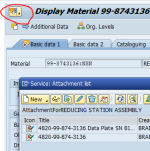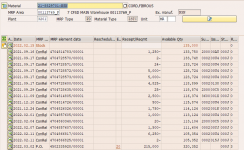So I'll give you a good example of what we're working with in the EPM. We spent about two months in the summer with every LCMM reviewing every catalogued NSN in the inventory to update the 'min/max' and required supply levels. Those are theoretically in DRMIS, and should trigger automatic buys when you get below certain stock levels, but also let the LCMMs tag things as 'insurance items', which are those long lead parts that almost never break, but when they do you are foxed. We usually have major gear components for that reason, as the lead time will usually be in the 2-3+ years timeframe.
Because of the extended procurement times, we used two years worth of supply as the rule of thumb for setting the min levels to trigger a new order.
In reality, there isn't sufficient SM/procurement to process those autobuys, and we can't afford it, so all of it goes into a pile that is picked at when we can.
Knowing that, LCMMs manually push orders to get filled, but with the limited SM/Proc Os, they also go into a pile that is picked at when they can, with HPRs getting the priority. At busy times even HPRs are getting triaged because there isn't enough people, and not unusual to have a 3-4 month processing time for HPR procurements to be on the street.
So frequently things that are HPRs are HPRs because the routine re-supply under the min/max isn't happening, and we're doing everything manually, with a fraction of the staff, a lot of new people, and not enough of the right kind of beans to buy stuff.
A lot of collective frustration in both the SM/LCMM side about it, as and I see a few HPRs a week that have been on our 'buy list' for a year or more. COVID isn't helping and we had a few suppliers shut down at various points (or had their suppliers shut down at various points) so even when we get contracts out the EDDs can sometimes blow months or years past the contract date. We had one supplier be honest and tell us that when they did start up, their priority was filling the USN orders first, so we don't even have any real buying power in a lot of cases.
So sure, there has to be a balance, but a lot of the assumptions on lead time and process time are right out the window, which pushed our tower of cards right over, and basically broke things. It's bad enough we're looking at an ISSC to basically do the basic item procurement (and warehousing) functions, because that drops the LOE on the procurement side to a single big contract management, instead of thousands of buys.
So it's not that LCMMs aren't aware of the supply chain impacts or the storage requirements; things are just so f&d it's just not even on our radar of things to care about, because we will usually spend more on workarounds then the parts for a full fix are worth. If we have a shelf full of stuff normally we're just relieved to have actual parts somewhere.
Did find some obsolete NSNs against my own TA code from the 50s and 60s though; they were so old that took forever to figure out what they actually were, and had to go to e-bay to find some background. Those will be disposed of at some point, but on the Navy side we did our best to clear out a lot of the obsolete equipment when we disposed of the tankers and 280s, which also came along with a lot of extra stuff as scrap weight with de-militarization instructions to get rid of it. Obviously missed some of it, but we cleared out a few hundred tonnes of excess stuff that had been sitting around for a few decades, so progress.







